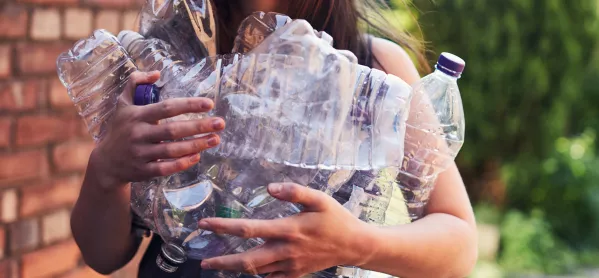- Home
- How to cut plastic from your classroom using three Rs
How to cut plastic from your classroom using three Rs

With estimates that by 2050 there could be more plastic in the ocean than fish and the knowledge that it can take over a thousand years for a plastic bottle to break down, the need to reduce our use of plastics has never been greater.
And there’s no reason that this sustainable mindset can’t carry through to the (typically resources intensive) world of the classroom.
Read more: 6 ways to bring climate change to the curriculum
From the magazine: How a SEND diagnosis affects teachers’ judgement
Listen: Why we’re doing too much, too young in education
It’s an unavoidable fact that the majority of teaching resources (especially in early years and key stage 1) are made from plastic, given its durable, cleanable and affordable nature.
There’s no need to throw things out for the sake of changing to a more sustainable material, but if you are in need of something new, consider where it comes from and if possible, try and repurpose something else.
The traditional classroom “three Rs” can just as easily stand for the sustainable favourites of “reduce, reuse, recycle”.
Reduce
- Always consider if you need to produce new resources or print a worksheet - can you teach your lesson and record assessment information in a different way?
- For example: rather than labelling a worksheet of an animal’s lifecycle, ask children to mould it using modelling clay and then lay this out with labels on a re-usable white board - and why not photograph it for evidence?
- For crafts, could you forage for materials outside rather than buy new plastic materials? For example: try creating a large bird’s eye view picture by laying down a bedsheet and using gathered materials (leaves, pinecones, twigs etc) to produce an image. Make sure to return all your gathered materials at the end - use this as a link to explore habitats and which animals might use them for their home.
Reuse
- Plastic bottles are one of the most common items of litter in our ocean. Try your hand at junk modelling using plastic bottles to find new ways for them to be used in the classroom.
- For example: make them into bird feeders to attract and study native bird species; create plant pots to show children how roots grow; piggy banks to explore the value of money; pen pots; skittles for a bowling game, etc - see what your class comes up with!
- Ask parents to bring in their used squeezy ketchup and sauce bottles as a great mess-free option for paint.
Recycle
- Run litter-picking activities around the school site and then spend time with your class sorting what you collect into different materials. A perfect learning opportunity to explore material types while teaching them what can or cannot be recycled (remember to wear gloves!).
- Decorate different types of bins to look like different monsters or animals. Incorporate them into your lessons of teeth and diets and encourage students to feed the bins the different “foods” that they prefer (paper/cardboard, plastic etc).
- Run recycling contests between different classes to motivate them to collect as much as possible.
Pupil-led efforts
Underpinning all this must be a focus on giving students ownership of the problem and how the school will tackle it.
As the generation likely to be living with the long-term consequences of today’s environmental issues, fostering environmental awareness in students from an early age has never been more important.
By giving your students ownership of projects to make your classroom more sustainable you’ll help highlight that individual action can make a difference and hopefully empower them to take these ideas into their later life.
- For example: task your students with identifying which type of single-use plastic is used most in your school (usually cups/lids, bags, bottles and straws) and ask them to design an action plan to reduce this.
- Nominate a group of students to be the “plastic police” and run regular counts of plastic bottles around the school so they can find out first hand if their action plan has had an impact over time. This data could be used to explore different forms of graphs and displaying data.
- Ask your students to keep a plastics diary for the week and note down all the plastic they use. A great introduction to different materials as well as sustainability, and could extend into finding ways to reduce plastic pollution at home.
Holly Bestley is a senior learning officer based at ZSL (Zoological Society of London) - the international conservation charity behind ZSL Whipsnade and London Zoo
Keep reading for just £1 per month
You've reached your limit of free articles this month. Subscribe for £1 per month for three months and get:
- Unlimited access to all Tes magazine content
- Exclusive subscriber-only stories
- Award-winning email newsletters